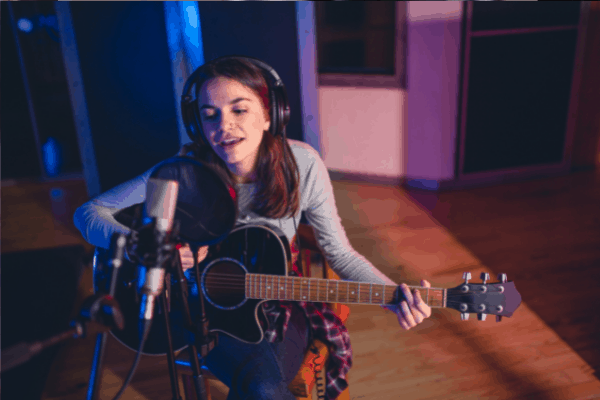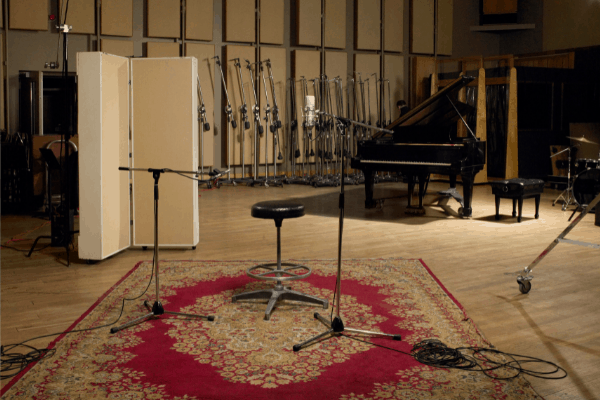Do you ever wonder how recording studios make our favorite songs sound great? A lot of it has to do with the architecture and design of the buildings the songs are recorded in and the wood flooring recording studios typically use.
6 Reasons recording studios have wood floors:
- Wood floors help with the acoustics of the music.
- They match the aesthetic of the studios.
- Musicians can perform better on wood floors.
- Wood floors create balance in the recording studios.
- It’s easier to move furniture on wood floors.
- Wood floors are easy to clean and maintain.
Many famous talents often move to and from recording studios, so it is important to make sure the recording studio works for them and their music. In this article, we’ll examine exactly why recording studios are usually made with wood floors.

Wood Floors Help With the Acoustics of the Music
Getting music to sound just right isn’t easy. You need to consider the room’s shape, its furniture, and the material it uses. For these reasons, recording studios are typically built with wood floors, creating the perfect sound.
The study of acoustics in a room, or acoustical designing, is very specific. Even the best architects find it difficult to master.
The room has to be shaped just right using the correct dimensions and textures built into it. You will know how good the architecture of a studio is when it can produce the right acoustic environment.
Traditional hardwood is the best type of wood flooring for acoustics and can often be found in recording studios. It is more popular for acoustics than other wood floorings, such as laminate. Despite not often being recognized as a type of wood flooring due to its plasticky look, laminate is a type of wood floor.
Hardwood is the best for acoustics due to its solidness. It provides a sturdy and dense base for sounds to bounce off. Sometimes, an acoustic underlay is also installed underneath to reduce the effect of walking and moving, so you can focus more on the acoustic sounds for music. An acoustic underlay helps remove some of the echoes that may come with a wood floor.
How a wood floor is installed in a studio is also essential to the studio’s overall sound projection. Usually, a wood floor is either glued or nailed when installed. For recording studios, it is more beneficial to nail the wood down to increase sound acoustics. When glued down, many of the great sound acoustics are lost among the density of the glue.
Check out my ultimate guide to the best home recording studios flooring type
They Match the Aesthetic of the Studios
The overall aesthetic and look of a place are important, especially in cities like LA or Nashville, where many stars record their music or voice-overs. When it comes to the aesthetic and vibe of a recording studio, the goal is usually clean, chic, and professional. Wood floors help with this.
Hardwood floors are often associated with enhancing a space’s natural beauty and simplicity. The actual recording rooms are kept simple in a recording studio so that sounds don’t bounce off of unnecessary objects. A studio may have a stool, microphones, some instruments, and maybe a wall hanging or frame in it. Other than that, recording studio rooms are kept as simple as possible.
Oftentimes, hardwood can be seen in “fancier” establishments like offices or large houses. Many wealthier people like the look of hardwood floors because of the association the look has with success and cleanliness in the living space. It is easy to understand why celebrities frequently spend time somewhere like a recording studio, would also want to achieve this vibe.
The type of wood flooring can also contribute to the aesthetic of the recording studio. Often, hickory wood is used for its range of light to medium shades. It can also be stained a darker brown. Oak is also a popular flooring choice, with red oak growing in popularity due to its rich color.
Musicians Can Perform Better on Wood Floors
Since wood floors help with acoustics, it overall helps the musician perform better. When a musician can listen to themselves in good acoustics, psychologically their brain wants to keep creating pleasing sounds. Indeed, wood flooring is best for performance value. That’s why many small venues, theaters, and stages have wood floors.
The acoustics of the wood flooring benefits the musician or performer’s sounds, whether they’re singing or performing stand-up. In turn, they want to continue the performance since it is pleasing to both them and the audience.
The artist’s performance also ties to the aesthetic of the room, which we talked about earlier. Artists are in a better headspace mentally when they’re in a clean and crisp environment that provides a good vibe from the overall look. Wood floors can contribute to this feeling for them.
Hardwood is also easier to clean than other types of flooring. Unlike carpet or tile, it does not catch debris as easily and can be cleaned or vacuumed quickly. This eliminates the risk for accidents and mishaps caused by cluttered or unsanitary floors while the musician is performing.

Wood Floors Create Balance in the Recording Studios
If you’ve ever studied interior design, you would know that one of the most important things in designing a room is creating balance through decoration. This includes dimensions, colors, textures, and more.
Music studios are often built with plaster coatings around the walls to eliminate extra vibrations from the noise hitting the wall. The plaster can give off a shiny effect. In turn, wood floors can also give a shiny effect, making the room’s design feel consistent and balanced.
Wood floors are also a neutral color. This means they match with most wall paints as well as any other furniture in a room. Recording studios are also very modern in terms of equipment and talent. Wood flooring, especially hardwood floors, can give an old building an enhanced, modern look. This creates a balance between the room’s design and the items within the room.
The dimensions of a recording studio can also be on the smaller side so that music doesn’t escape through the room’s space. A smaller space is often better for acoustics. Wood flooring can make a room feel bigger since it is flat and neutral in color. Other floorings like carpet struggle to do the same as they can differ in length and color.
It’s Easier To Move Furniture on Wood Floors
Music equipment can be heavy. Large instruments, microphones, and other supplies can be very difficult to move across uneven surfaces. Wood floors make moving some of this heavy equipment around the room easier.
If recording studios were to use carpets, it would be harder to move heavy furniture around. Wood is easy to slide supplies across, and the supplies will not create dents in the floor like it would with carpet.
For example, if you are moving a heavy drum set from one corner of a recording studio to the other, it would ideally be easier to slide some of the pieces to the other side while being careful not to damage the floor. This is where wood floors come in handy.
Wood Floors Are Easy To Clean and Maintain
Earlier, I discussed why it’s important to have an uncluttered studio to ensure that the musicians don’t trip and injure themselves. Therefore, wood floors are commonly used to make cleanup easier; other types of flooring are harder to clean.
Musicians spend a lot of time at the recording studio, so it’s no surprise if they bring in food and snacks into the studio – they may even spill their coffee on the floor. Carpets are the worst should this happen because they can easily absorb the liquid. But with wood floors, a swift cleaning/wipe will do. The smell won’t stick, either!
For more information, check out which is better for home studios between carpet flooring vs. hardwood flooring
Sources
- Merriam-Webster: aesthetic
- T&G Flooring: Acoustic Properties of Hardwood Floors
- Design Network CarpetsPlus Colortile: The Aesthetic Appeal of Natural Hardwood Floors
- HGTV: Hardwood Flooring
- Archive.org: Acoustical designing in architecture [by] Vern O. Knudsen [and] Cyril M. Harris
Recent Posts
QuickTime is a vital app for many Mac users, and if you’ve recently bought a new microphone, you might wonder how to use it optimally. QuickTime cannot record audio content if it doesn’t have...
Every microphone leaves a unique signature on the quality of its output. If you’re a podcaster trying to melt your way into your audience’s hearts, a muddy, distorted recording won’t cut it....
